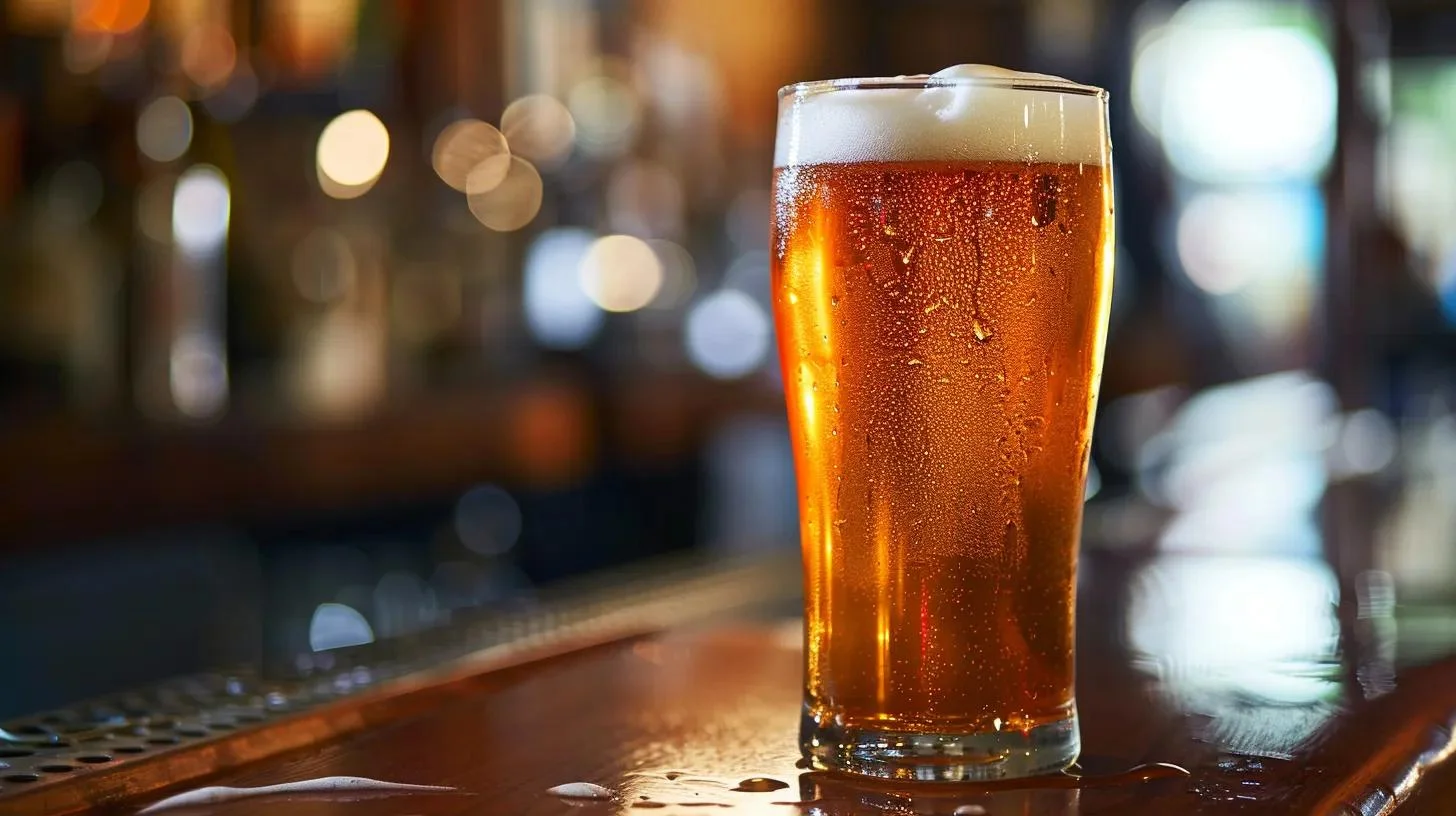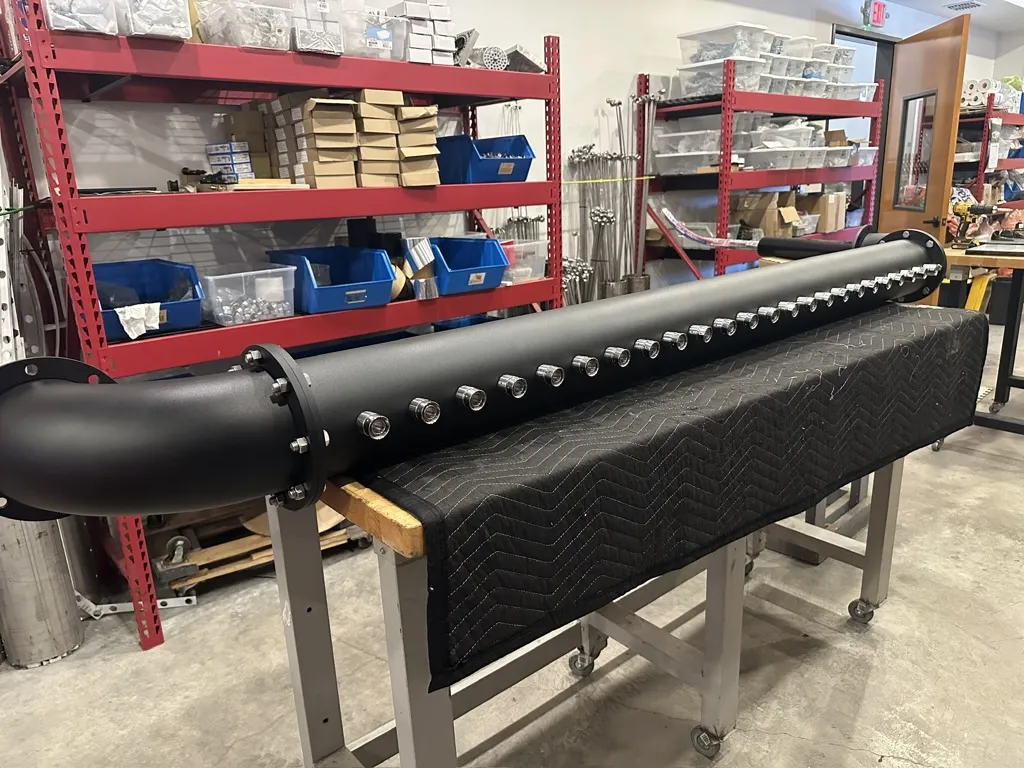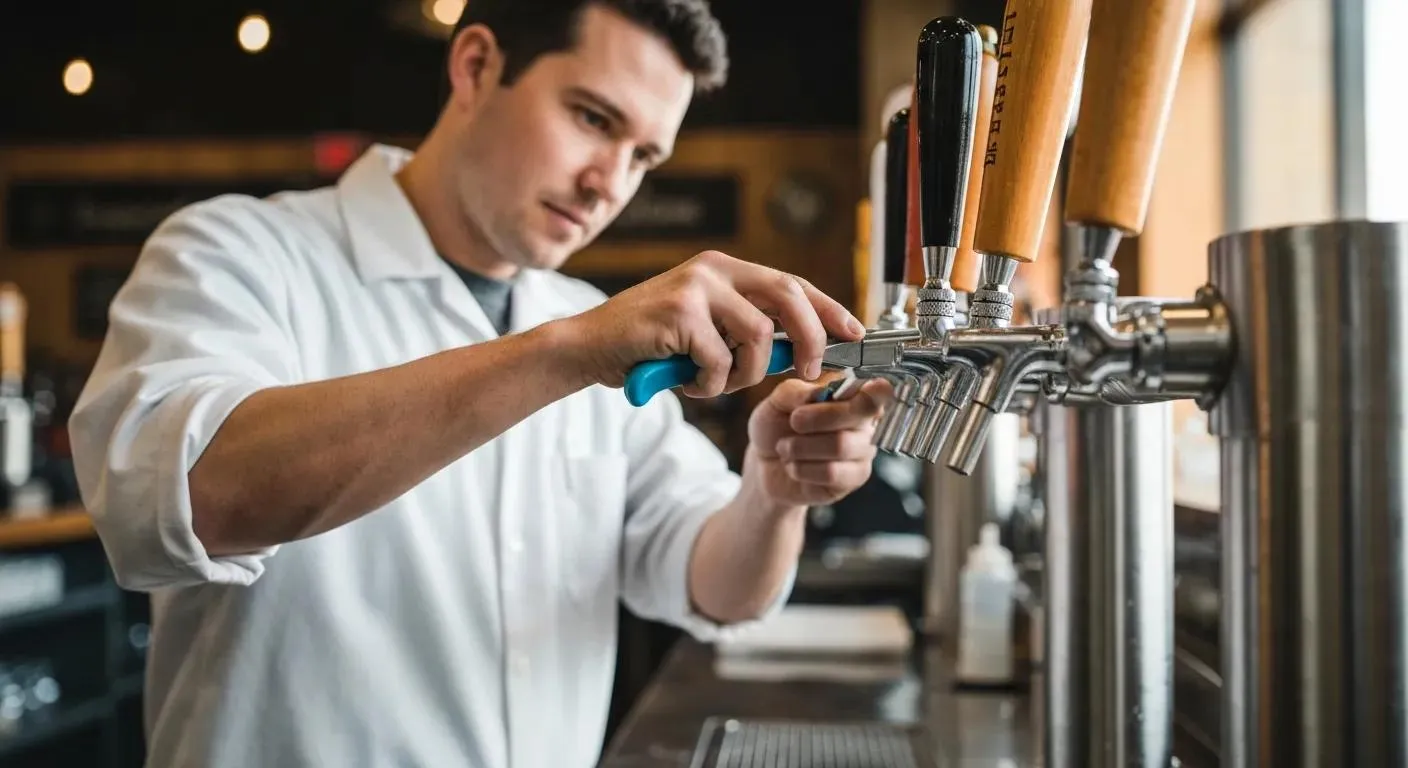The True Cost of a Bad Pour: Why Renny's Draft Solutions Are Central Oregon's Essential Draft Beer Technicians

A "bad pour"—too much foam, off-flavors, or low yield—takes money out of every keg you serve. This guide breaks down how those losses stack up in cents per pint and dollars per keg, explains how microbial growth and beer stone create off-flavors, and shows how regular cleaning, thoughtful maintenance, and properly designed draft systems stop the leak.
You’ll get worked examples to calculate local losses, a comparison of cleaning methods and their effectiveness, practical troubleshooting that staff can run, and design rules for custom installs that minimize recurring waste.
Our goal is to give Bend and Central Oregon restaurant, bar, and brewery managers clear, actionable steps to boost keg yield and guest satisfaction—and to show where certified technicians fit into that plan. Throughout, we point to local service options and certifications that close the loop between diagnosis and long-term performance.
What Is the Financial Impact of a Bad Draft Beer Pour?
Bad pours hit your bottom line two ways: visible product loss and hidden operational costs. Foam and off-taste make pints too small or unsellable, while contamination speeds keg spoilage. Start by calculating cents lost per pint, then scale to dollars per keg and annual loss based on your keg turnover. Those numbers let managers weigh the cost of reactive fixes against scheduled cleaning and maintenance and build a simple ROI case for professional service. The sections that follow walk through examples and list the less-visible expenses that magnify direct losses—so you can present a clear business case for intervention.
How Much Revenue Do Bars Lose from Foamy and Off-Taste Beer?
Use a per-pint approach: if 4 oz of a 16 oz pint is foam and unsellable, that’s a 25% loss on that pour. Translate foam percentage to keg volume: a standard U.S. keg (15.5 gallons) yields approximately 124 pints; losing 10% of the yield means roughly 12 pints are wasted per keg. Multiply lost pints by your margin per pint to get dollars lost per keg, then scale by monthly keg turnover to annualize the damage. Do this for low-turn bars and high-turn brewpubs to prioritize where cleaning and maintenance give the fastest payback.
Different loss scenarios and their annualized impact:
That table makes ROI easy to see: even minor yield improvements recover thousands of dollars, which helps justify investments in cleaning and maintenance.
What Are the Hidden Costs Beyond Wasted Beer?
Bad pours don’t stop at wasted beer. They drive customer churn, damage your reputation, speed equipment wear from corrosive deposits, and increase staff time spent troubleshooting and discarding product. One bad drinking experience can cut into tap sales and slow turnover. Beer stone and biofilms also put extra strain on fittings and regulators, raising repair and replacement costs. Accounting for these indirect costs strengthens the case for preventive programs that protect revenue and your brand—leading naturally into recommended cleaning cadences and maintenance plans.
Hidden costs typically include
- Customer churn and lost lifetime value: off-flavors drive repeat guests away.
- Brand and review damage: Negative impressions reduce new customer traffic.
- Accelerated equipment wear: deposits increase the frequency of repairs and replacements.
Together, direct and hidden costs create a strong business case for scheduled cleaning and professional maintenance.
Why Is Professional Beer Line Cleaning Crucial for Draft Beer Quality in Bend, Oregon?
Professional line cleaning removes the microbes and mineral deposits that change flavor and reduce yield. That means breaking up biofilms and dissolving beer stone with the right caustic and acid chemistries, aided by mechanical recirculation to reach every inch of tubing and fittings.
In Central Oregon, temperature swings and busy systems speed fouling, so choosing the correct method matters—professional services target contaminants while minimizing downtime and protecting faucet and coupler finishes.
The immediate payoffs are a cleaner flavor, better keg yield, and longer intervals between component failures. Below, we explain how contamination works and compare cleaning approaches by effectiveness, cost, and downtime to help you decide.
How Does Beer Line Cleaning Prevent Off-Flavors and Contaminants?

Off-flavors come from microorganisms—Pediococcus, Lactobacillus, Pectinatus, Acetobacter—and from beer stone (calcium oxalate) that traps aroma compounds. These form biofilms that keep producing sour or phenolic notes until removed. Effective cleaning utilizes alkaline cleaners to dissolve organic residue, followed by acids to attack mineral scale. Mechanical recirculation enhances contact and shear, facilitating the dislodgement of biofilms. Rinsing and verification remove residual chemistry. Because microbes and beer stone can re-form, a systematic cleaning schedule interrupts the contamination cycle and restores consistent taste on future pours.
What Cleaning Methods Does Renny's Draft Solutions Use to Ensure Freshness?
Commercial cleaning options vary, but the most reliable method uses recirculation with targeted caustic and acid phases, disassembled faucet and coupler cleaning, and verification rinses. That approach removes most microbial and mineral buildup with predictable downtime.
Renny's Draft Solutions—Micro Matic certified and brewer-owned—uses recirculation where it’s the right fit, plus thorough faucet and coupler inspections to ensure full restoration. For high-yeast lines or sour programs, they increase acid frequency or shorten intervals to prevent re-establishment of organisms. Managers can request a consultation to match cleaning cadence to beer styles and turnover, as explained in the cleaning frequency section.
A comparative view of cleaning approaches:
Recirculation generally offers the best balance of removal effectiveness and predictable downtime for commercial systems. Next, we’ll look at how ongoing maintenance compounds those benefits.
How Does Draft Beer System Maintenance Maximize Profitability in Central Oregon?
Maintenance keeps your system balanced—temperature, pressure, and gas ratios—which prevents foam and stabilizes pours. A well-tuned system reduces forced dispensing, lowers CO₂ waste, and preserves beer quality. Preventive tasks—gasket replacement, regulator calibration, and glycol chiller checks—keep components within spec and cut emergency repairs.
Businesses that pair scheduled maintenance with line cleaning see fewer flavor incidents and slower equipment degradation, which extends component life and lowers replacement costs.
What Are Common Draft System Issues That Cause Bad Pours?
Common failure points include unbalanced pressure, warm or dirty lines, wrong temperature,dirty faucets and couplers, worn gaskets, and misadjusted regulators—each can cause excess foam, slow pours, or off-flavors. Quick diagnostics include checking the beer temperature at the faucet, listening for regulator drift, and inspecting faucet interiors for beer stone. Staff can run simple tests—such as pulling a pint and temping it, checking CO₂ pressure , and confirming glycol circulation—to triage issues before calling a technician. Start with temperature and pressure balance, then move to cleaning and gasket replacement to reduce lost sales quickly.
A short troubleshooting checklist:
- Check serving temperature: a cold, steady temperature cuts foam.
- Verify pressure/regulator settings: small tweaks control foam and CO₂ use.
- Inspect faucets and couplers for deposits: visible build-up means cleaning is needed.
These quick checks flow into scheduled maintenance tasks that preserve equipment life and taste.
How Does Regular Maintenance Extend Draft System Lifespan and Improve Taste?
Regular maintenance replaces worn parts before they fail, keeps dispense parameters stable, and catches small leaks or temperature issues that would otherwise speed wear on regulators and chillers. Replacing worn gaskets prevents pressure leaks that overwork compressors, and calibrating regulators cuts CO₂ waste and avoids over-carbonation off-flavors.
Documented service cycles reduce emergency downtime and give consistent pour profiles that encourage repeat business. The combined effect: lower operating expense and higher captured revenue through better keg yields and happier guests—an easy ROI case for preventative contracts.
Benefits of compliance include:
- Longer component life and reduced capital replacement costs.
- Consistent sensory experience that supports customer retention.
- Fewer emergency repair hours and more predictable maintenance budgeting.
What Should Businesses Know About Custom Draft System Installation in Central Oregon?

A custom draft install aligns equipment and design to reduce pour variability—matching line length, cooling capacity, gas regulation, and fittings so beer arrives at the faucet at the right temperature and pressure. Choices like glycol chiller sizing, CO₂/Nitrogen plumbing, proper line lengths, distances, and correct keg couplers and faucets all affect pour consistency and operating cost. Investing in a custom system typically reduces recurring waste, CO₂ loss and maintenance hours compared to piecemeal installations. The sections below outline the performance benefits and the components technicians use to meet those goals.
How Does a Custom Draft System Improve Beer Quality and Efficiency?
A custom system accounts for your variables—distance from keg room to bar, number of taps, beer styles, and expected turnover—and sizes line diameter, slope, and cooling to minimize pressure loss and temperature drift. Properly sized glycol chillers and insulated trunk lines hold serving temperature steady, reducing foam and extending shelf life; matched regulator setups deliver consistent gas blending to avoid over-carbonation.
ROI shows up as fewer rejected pints, lower gas bills, and less labor troubleshooting—often paying back in months compared to repeated emergency fixes. Clear rules of thumb and post-install testing ensure predictable performance.
What Equipment and Design Features Does Renny's Provide?
Technicians specify parts that directly affect pour quality: keg couplers that match brewery fittings, beer lines sized for flow and distance, stainless faucets with cleanable assemblies, regulators for stable delivery, and glycol chillers sized to handle the load.
Renny's Draft Solutions installs and balances systems with those priorities and offers installation, system balancing, and staff training. The result: fewer foam incidents, lower CO₂ waste, and easier maintenance. Request a consult and we’ll map equipment choices to expected yield improvements for your operation.
This component matrix shows why each choice matters for taste and long-term operational efficiency.
Why Choose Renny's Draft Solutions as Your Central Oregon Draft Beer Technician?
Choosing the right technician means combining certification with local experience. Renny's Draft Solutions pairs a brewer-owned perspective with Micro Matic certification—bringing sensory know-how together with industry-standard equipment practice.
Family-owned and run by two brothers with deep draft experience, Renny’s has worked with notable Central Oregon clients and understands both the microbiological causes of off-flavor and the mechanical tuning needed for consistent pints. The following sections explain the brewer-owned advantage and summarize client outcomes without inventing specifics beyond the provided client list.
How Does Renny's Brewer-Owned Experience Benefit Your Business?
Brewer-owned technicians bring hands-on sensory calibration and operational empathy. They can often diagnose a sour note or a creamy head faster because they’ve lived the production and dispense side of brewing. That insider view leads to targeted cleaning and system adjustments that fit brewery and taproom workflows. Paired with Micro Matic certification, this experience helps prioritize the fixes that improve both yield and guest experience—saving time and producing measurable results after service.
What Do Central Oregon Breweries Say About Renny's Services?
Renny's works with several recognizable Central Oregon clients across brewery and hospitality settings; named local clients include Deschutes Brewery, 10 Barrel Brewing Co., Crux Fermentation Project, Mt. Bachelor, and Sunriver Brewing Company. Those engagements span large taprooms and retail hospitality operations. Operators typically report more consistent taste and increased keg yield after cleaning and balancing. While we don’t reproduce individual testimonials here, the local feedback shows certified, brewer-informed services narrow the gap between production quality and everyday pours. Visit our testimonial page.
Central Oregon clients indicate that Renny's experience includes
- Large brewery taprooms that require high-turn solutions.
- Brewpubs and restaurants focused on a consistent guest experience.
- Resort and event venues need reliable service under variable loads.
These client types demonstrate the approach’s relevance across local use cases and lead into the recommended cleaning cadence.
How Often Should Beer Lines Be Cleaned to Avoid the Cost of a Bad Pour?
The Brewers Association recommends cleaning draft lines at least every two weeks; many Central Oregon operators use that cadence as a baseline. Higher-risk situations—high-yeast beers, long dwell times, or mixed-fermentation programs—call for more frequent cleaning, sometimes weekly or per-keg, to protect flavor.
Making cleaning a scheduled operational task reduces surprise downtime and preserves taste and keg yield. The sections below give the recommendation, quantify likely sales improvements from compliance, and close with a clear next step for businesses ready to act.
What Are the Brewers Association's Recommendations for Cleaning Frequency?
The Brewers Association recommends cleaning draft lines at least every two weeks because biofilms and beer stone can form quickly and create sensory and microbial problems. Exceptions include sour and wild beers, high-yeast lagers, or lines with extended dwell times—these should be cleaned more often based on taste and turnover. Use taste checks and a simple line-cleaning log to validate cadence and increase frequency if off-flavors recur. Following the Brewers Association baseline gives you a defensible standard for health, taste, and yield protection.
How Does Regular Cleaning Increase Sales and Reduce Waste?
Regular cleaning restores flavor clarity and increases keg yield by cutting foam and unsellable volume—often producing single-digit percentage lifts in draft revenue after consistent cleaning and maintenance begin. Gains come from repeat business, fewer wasted pints, and steadier tap turnover that reduces spoiled product. For budgeting, estimate recovered margin per keg and multiply by monthly kegs to forecast monthly revenue gains; that math frequently justifies contracted cleaning and scheduled maintenance in a matter of weeks. If you want help converting these numbers into an operational plan, Renny's Draft Solutions can consult and schedule services to align cleaning cadence with your beers and turnover.
Benefits of compliance:
- Reduced foam and wasted pints, increasing sellable volume.
- Improved guest retention from consistent flavor.
- Lower repair and emergency service costs over time.
If you’d like help turning these savings into an exact ROI for your location or to schedule professional cleaning and maintenance, contact Renny's Draft Solutions for a consultation and custom quote; their brewer-owned, Micro Matic-certified team will assess your system and recommend a tailored plan.
Frequently Asked Questions
What are the signs of a poorly maintained draft beer system?
Look for excessive foam, off-flavors, slow pours, and inconsistent serving temperature. Customer complaints about taste, faucets that are hard to operate, or visibly worn or gunky faucet internals are clear signs that maintenance is overdue. Regular inspections and cleaning prevent these issues and keep service quality high.
How can I calculate the ROI of investing in professional draft beer services?
Estimate current losses from bad pours (wasted beer and hidden costs like customer churn), then add the cost of professional cleaning and maintenance. Compare the recovered revenue from improved keg yield and better customer retention to service expenses. A simple ROI formula is: (Revenue Recovery - Service Cost) / Service Cost × 100 to get the percent return.
What should I look for when choosing a draft beer technician?
Check certifications, hands-on experience, and local references. Look for technicians certified by recognized vendors like Micro Matic and those with a proven track record in hospitality and brewery environments. A brewer-owned background is a plus—it brings actionable sensory and operational insight that improves diagnosis and outcomes.
How does temperature affect draft beer quality?
Temperature is critical. Too warm and beer foams and off-flavors become more noticeable; too cold and flavor and aroma can be muted. Serve at a consistent, style-appropriate temperature to preserve the beer’s profile and ensure a smooth pour. Regular cooling system maintenance is essential to hold that setpoint.
What are the benefits of a custom draft beer system installation?
Custom installs optimize equipment for your specific needs—line length, cooling capacity, and gas regulation—reducing pour variability and waste. The result is better temperature control, consistent pressure delivery, fewer off-flavors, and lower operating costs. Over time, those improvements translate to tangible savings and happier guests.
How often should I conduct maintenance on my draft beer system?
Follow the Brewers Association baseline of cleaning at least every two weeks, and perform additional maintenance as recommended (gasket replacement, regulator checks, glycol service). High-yeast beers or long dwell times may require weekly or per-keg cleaning. A consistent schedule protects beer quality and extends equipment life.
Conclusion
Bad pours cost more than spilled beer—they erode profit, reputation, and equipment life. Investing in professional cleaning, regular maintenance, and right-sized system design recovers lost margin, improves taste consistency, and keeps guests coming back.
Renny's Draft Solutions offers tailored, brewer-informed services that align with your operation to maximize yield and reliability. Contact us to see how we can help raise your draft service to the next level.



